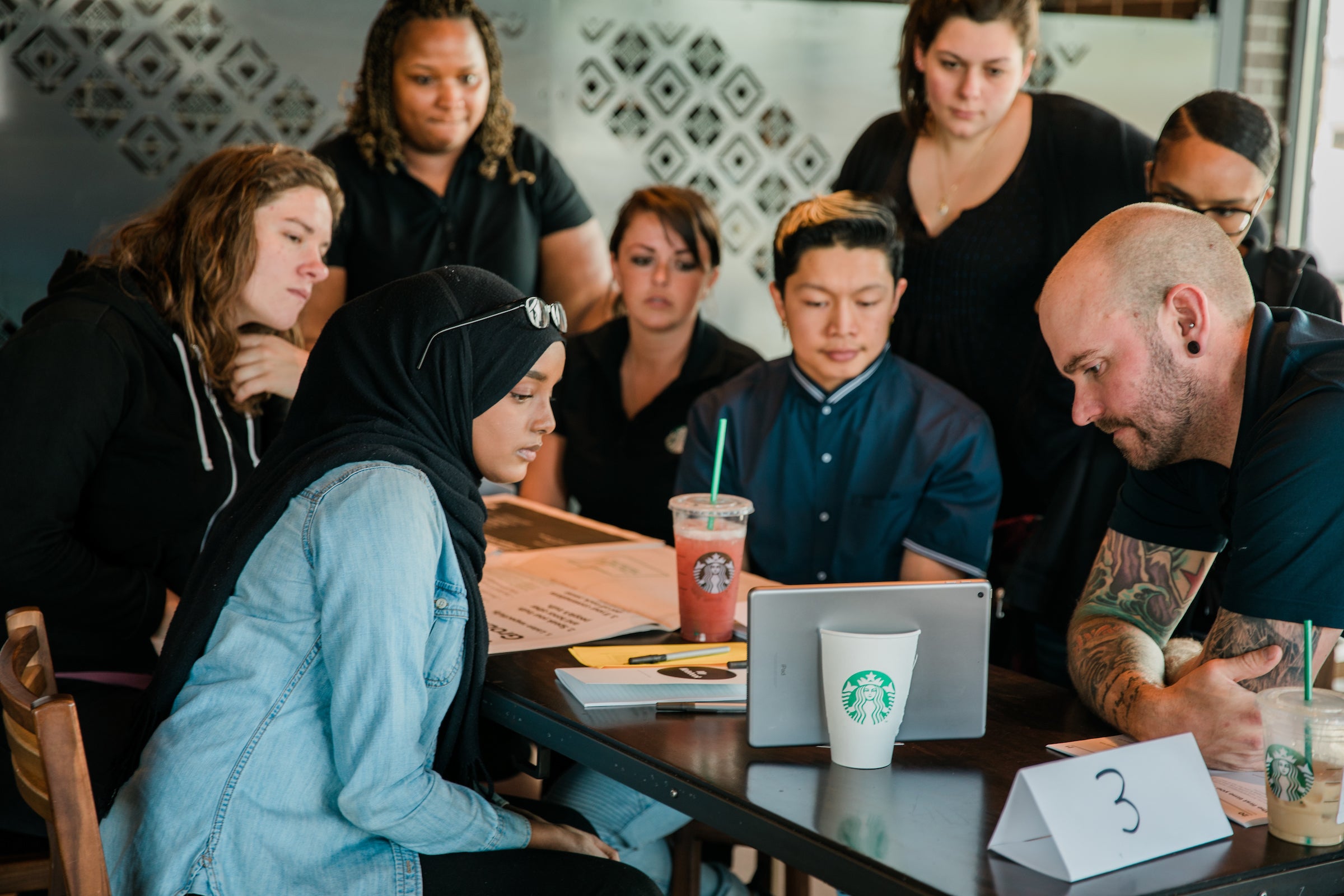WHAT STARBUCKS EMPLOYEES LEARNED ON THEIR RACIAL BIAS TRAINING DAY

Much has been made of Starbucks’ decision to close 8,000 of its shops across the US yesterday to conduct diversity training, after the arrest of two black men at one branch caused controversy.
While some lauded the coffee shop behemoth for taking action against racial bias, others have condemned the move as nothing more than a publicity stunt.
The four-hour “bias training” programme was designed to encourage Starbucks employees to examine implicit biases they may hold when dealing with people of different ethnicities, genders or backgrounds.
Starbucks has now revealed exactly what the training involved by sharing the guide online.
The guide goes through Starbucks’ mission and values before moving on to sections on how to understand bias and make all customers feel like they belong.
Each section of the training featured some form of “inspiration,” be that “a film, a look into mind science or a leader sharing a story”, followed by “self- or group reflection and a chance to practice.”
Employees were encouraged to reflect privately by writing in notebooks and were also asked to think about biases.
“Stereotypes are shaped by the things we take in around us. Much of it comes through the media, but also our experiences and the broader culture we live in,” the guide reads.
“The risk is that when we hold negative stereotypes, unconscious bias can arise. When we are under pressure, are short on time or don’t pay attention, unconscious biases are triggered more easily.
“We can hold biases about race and age and religion. Gender and sexuality and body type. Ability and mental health and class. And many other attributes.
“That’s why it’s important that we learn about how our biases are framed and what we can do to override them.”
There is one section of the guide that that has raised eyebrows on social media, however.
Employees were asked to:
“Recall when you first experienced your racial identity. It may have been when you were a child. It may have been last week. If a scenario doesn’t apply to you, feel free to leave it blank and move on to the next one.
“...noticed your racial identity.
“...noticed how your race affected beauty standards.
“...felt your accent impacted people’s perception of your intelligence or competence.
“...altered your communication style (dialed it up or down) to avoid playing into stereotypes.
“...had a friend of a different race who regularly visited your home.
“...felt distracted at work because of external events related to race.
“...had a senior role model in your organization with a similar racial identity as your own.
“...went to work with your natural hair without comments or questions from others.
“...felt your race affected your ability to build a rapport with your manager.”
Staff members were also asked to rate how easy or hard they would find it talking to people of their own race and of a different race in various situations.
“Most of us think we treat other people fairly,” it goes on. “Upon reflection, do you notice ways in which you treat people differently? The point here is not to judge whether that is a good or bad thing, but merely to notice.”
It also explains various terms such as 'prejudice', 'racial anxiety' and 'implicit bias'.
“May 29 was a day of open and honest conversation starting with our partners,” a Starbucks spokesperson said.
“Our decision to close stores for racial bias learning and education was sparked by Philadelphia, so we wanted to engage in race first. Over the next months and years, we will go into different forms of bias by adding more learning sessions on understanding bias, inclusion, use of the third place, leadership, among other topics.
“Starbucks is also looking forward to attending a convening this summer, hosted by the Leadership Conference on Civil and Human Rights as we take the next steps toward understanding how can address other forms of bias and how companies can best implement these lessons. As we have said, May 29 is one step in a long-term journey.
“For longer term efforts, Starbucks will also consult with a diverse array of organisations and civil rights experts - including The Anti-Defamation League, The Leadership Conference on Civil and Human Rights, UnidosUS, Muslim Advocates, and representatives of LGBTQ groups, religious groups, people with disabilities, and others.
“We will continually assess our progress and remain open to engaging with other groups as merited.”
Article Source: https://www.independent.co.uk/life-style/starbucks-diversity-training-racial-bias-us-store-closures-america-what-learned-a8376011.html
Image Source: https://static.independent.co.uk/s3fs-public/thumbnails/image/2018/05/30/15/anti-bias-training-2-0.jpg
VOCABULARY WORDS:
1. Laud (v.) ~ praise (a person or their achievements) highly, especially in a public context
2. Behemoth (n.) ~ something enormous, especially a big and powerful organization
3. Publicity student (n.) ~ planned events made to gain exposure and get public's attention
4. Override (v.) ~ use one's authority to reject or cancel (a decision, view, etc.)
5. Rapport (n.) ~ a close and harmonious relationship in which the people or groups concerned understand each other's feelings or ideas and communicate well
6. Bias (n.) ~ prejudice in favor of or against one thing, person, or group compared with another, usually in a way considered to be unfair
7. Implement (v.) ~ put (a decision, plan, agreement, etc.) into effect
8. Array (n.) ~ an impressive display or range of a particular type of thing
QUESTIONS FOR DISCUSSION:
1. What do you know about the current controversy involving racial discrimination in Starbucks?
2. What is your opinion on the racial diversity training? Do you think it should mandatory for international companies? Explain your answer.
3. What do you think are the common causes of racial bias?